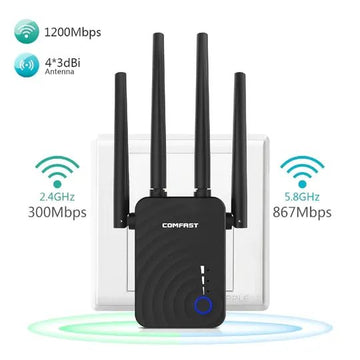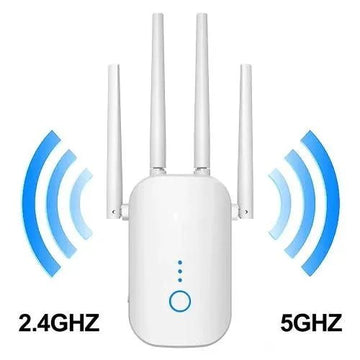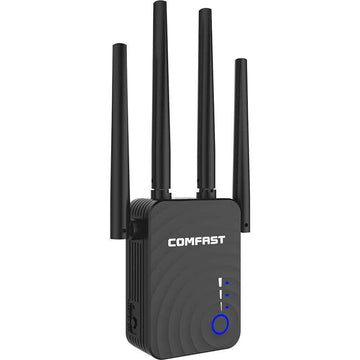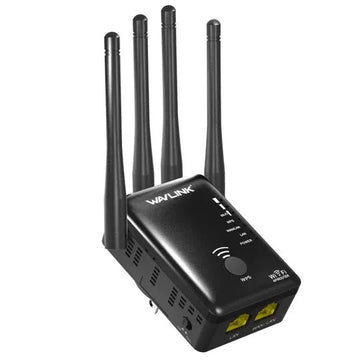Boosting Wifi Signals: Enhancing Connectivity in Busy Environments
In today's digital age, the demand for Wifi connectivity has skyrocketed, especially in busy environments such as office buildings, shopping malls, airports, and public spaces. People rely on Wifi for various activities, including work, communication, entertainment, and accessing online services. As a result, the need for strong and reliable Wifi signals has become paramount.
One of the significant challenges faced in busy environments is Wifi interference. When numerous Wifi networks and electronic devices coexist in a confined space, it leads to interference, causing signal degradation and reduced data transmission speeds. This interference can result from physical barriers, overlapping Wifi networks, and other electronic devices operating on similar frequencies.
Importance of boosting Wifi signals for improved connectivity
Boosting Wifi signals is crucial for ensuring seamless connectivity in busy environments. A strong and stable Wifi connection enhances productivity, facilitates smooth communication, and enables uninterrupted access to online resources. In today's fast-paced digital world, where reliance on Wifi is ever-increasing, a weak or unreliable connection can be frustrating and hinder daily activities. By addressing the issue of Wifi interference, which is common in crowded areas, we can provide users with a reliable and efficient internet experience. Boosting Wifi signals not only improves data transmission speeds but also reduces the chances of dropped connections and buffering during important tasks such as video conferencing, streaming, or downloading large files. It empowers individuals, businesses, and organisations to make the most of the digital landscape and stay connected with the world.
Understanding Wifi Interference
Wifi interference can arise from various sources, posing challenges to the strength and reliability of Wifi signals. Physical barriers such as walls, floors, and large objects obstruct the path of Wifi signals, reducing their strength as they pass through. The presence of multiple Wifi networks operating on the same or overlapping channels creates signal congestion and interference, further degrading the quality of Wifi connections. Additionally, electronic devices like microwave ovens, cordless phones, and Bluetooth devices emit signals that can interfere with Wifi transmissions, causing disruptions and signal degradation.
The impact of interference on Wifi signals is significant. Weakened signals result in decreased signal strength and range, affecting the coverage area of Wifi networks. As a consequence, data transmission speeds suffer, leading to slow internet connections, buffering issues during streaming, and frequent dropped connections. The severity of these issues escalates as interference increases, resulting in a subpar Wifi experience for users.
Busy environments present unique challenges due to the high density of Wifi networks and electronic devices. The concentration of signals in such environments intensifies interference, leading to degraded Wifi performance and limited coverage areas. This situation is especially prevalent in crowded areas like office buildings, shopping malls, or airports, where numerous devices and networks coexist. Overcoming these challenges requires implementing effective Wifi boosting techniques that address interference, strengthen signal strength, and extend coverage areas. By employing these techniques, users can enhance their Wifi experience, ensuring reliable connectivity in even the busiest environments.
Wifi Boosters: An Overview
Wifi boosters, also known as range extenders, repeaters, or mesh systems, are essential tools for improving Wifi signals in busy environments. These devices serve as intermediaries between the router and areas with weak signal strength. Wifi boosters work by capturing the existing Wifi signals, amplifying them, and retransmitting them to extend the coverage area and enhance connectivity.
There are different types of Wifi boosters available in the market to suit various needs. Range extenders are ideal for extending coverage in a specific direction, making them suitable for homes or small offices. They receive the existing Wifi signals and rebroadcast them, effectively expanding the coverage area. On the other hand, repeaters are placed within the range of the existing Wifi network and amplify signals to reach further distances.
Mesh systems offer comprehensive coverage in large areas by creating a wireless network with multiple access points. This setup ensures seamless roaming and optimal coverage throughout the designated space. Mesh systems are particularly useful in environments where consistent and reliable Wifi connectivity is critical, such as offices or commercial spaces.
Wifi boosters play a vital role in addressing Wifi interference and improving connectivity in busy environments. By amplifying and extending Wifi signals, these devices enable users to enjoy a stronger and more reliable connection, facilitating smoother communication, efficient data transmission, and uninterrupted access to online resources.
Choosing the Right Wifi Booster
When selecting the right Wifi booster, it is crucial to assess the specific requirements of the Wifi network and the environment where it will be deployed. Factors such as the size of the area requiring coverage, the number of users, and the presence of potential interference sources must be considered.
Determining the coverage area and understanding the required signal strength is essential. This knowledge helps in choosing a Wifi booster with an appropriate range and power to ensure optimal coverage throughout the designated space. Analysing the existing signal strength using Wifi analyser tools can provide valuable insights into areas that require improvement.
Several factors should be taken into account when choosing a Wifi booster. Compatibility with the existing Wifi network is critical to ensure seamless integration. Evaluating the range and speed capabilities of the booster is essential to meet the specific needs of the environment. Ease of installation and configuration is also important, as well as additional features such as Ethernet ports or mobile app support, which can enhance the versatility of the booster.
To make an informed decision, comparing different models and reading customer reviews can provide valuable insights into the performance and reliability of various Wifi boosters. By considering these factors, users can choose the right Wifi booster that best matches their requirements, ensuring optimal signal strength and improved connectivity in their busy environment.
Setting Up a Wifi Booster
A. Step-by-step guide on installing and configuring a Wifi booster
Installing and configuring a Wifi booster is generally a straightforward process. First, select an optimal location for the booster, preferably between the router and the area with weak signal coverage. Follow the manufacturer's instructions to connect the booster to the existing Wifi network. Finally, configure the booster settings through a web-based interface or a dedicated mobile app.
B. Tips for optimal placement of the booster to maximise signal strength
To maximise signal strength, it is crucial to place the Wifi booster strategically. Positioning it at a point where it can receive a strong Wifi signal from the router and transmit it to areas with weak coverage is essential. Avoid placing the booster in areas with significant physical barriers or interference sources.
C. Ensuring security and encryption settings are properly configured
During the setup process, it is vital to ensure that security and encryption settings are properly configured. Enable WPA2 or WPA3 encryption to protect the Wifi network from unauthorised access. Set a strong password and regularly update it to maintain network security.
Additional Techniques to Enhance Wifi Signal
A. Optimising router placement for better coverage
Optimising the placement of the router itself can significantly improve Wifi coverage. Position the router in a central location, away from physical barriers and interference sources. Elevating the router and avoiding obstructions can help minimise signal degradation.
B. Utilising channel selection and Wifi analyser tools to minimise interference
Wifi analyser tools can identify the channels used by nearby Wifi networks, allowing users to select channels with less interference. This reduces signal congestion and improves overall Wifi performance. Regularly monitoring Wifi signal strength and adjusting channels as needed can further mitigate interference.
C. Upgrading router firmware and equipment for improved performance
Regularly updating router firmware ensures access to the latest features and bug fixes, improving performance and security. Additionally, upgrading to newer Wifi standards, such as Wifi 6 (802.11ax), can enhance data transmission speeds and overall network capacity.
D. Incorporating a Wifi Extender for Extended Coverage
In addition to optimising router placement and utilising channel selection techniques, incorporating a Wifi extender is a valuable solution to enhance Wifi coverage in busy environments. A Wifi extender, also known as a range extender or repeater, acts as a bridge between the router and areas with weak Wifi signals.
Troubleshooting and Maintenance
A. Common issues faced with Wifi boosters and their troubleshooting solutions
Wifi boosters may encounter common issues such as intermittent connectivity, slow speeds, or compatibility problems. Troubleshooting steps may include checking the booster placement, rebooting devices, updating firmware, or adjusting settings. Consulting the manufacturer's support documentation or contacting customer support can provide further assistance.
B. Regular maintenance practices to keep the Wifi booster functioning optimally
To maintain optimal performance, regular maintenance practices should be followed. This includes periodic firmware updates, ensuring proper ventilation and temperature control for the booster, and cleaning or replacing antennas if necessary. Regularly monitoring signal strength and network performance can help detect and address any emerging issues promptly.
C. Monitoring Wifi performance and adapting as per changing environment
Monitoring Wifi performance is essential to ensure consistent connectivity. Use tools to assess signal strength, speed, and overall network performance. Adapt the Wifi booster's configuration or placement if changes in the environment, such as new physical barriers or interference sources, affect signal quality.
Future Trends and Innovations in Wifi Signal Boosting
A. Overview of emerging technologies in Wifi signal enhancement
The field of Wifi signal boosting continues to evolve, with emerging technologies focusing on improving performance and reducing interference. This includes advancements in beamforming, which directs Wifi signals toward specific devices, and the utilisation of multiple frequencies to enhance data transmission capabilities.
B. Potential advancements in overcoming interference challenges in busy environments
Innovations are being explored to overcome interference challenges in busy environments. Dynamic frequency selection, for instance, allows Wifi devices to dynamically switch to less congested channels to mitigate interference. Mesh systems with self-optimising capabilities are also being developed to intelligently manage Wifi signals in real-time, further reducing interference.
C. Importance of staying updated with the latest developments in Wifi boosters
To leverage the benefits of emerging technologies, it is crucial to stay updated with the latest developments in Wifi boosters. Keeping an eye on industry trends, attending technology conferences, and following reputable sources can help users make informed decisions when selecting Wifi boosters and implementing signal-boosting techniques.
Conclusion
Boosting Wifi signals in busy environments is essential for meeting the growing demand for reliable connectivity. It ensures smooth communication, seamless access to online resources, and improved productivity for users. In this article, we have delved into the increasing need for Wifi in busy environments and the challenges that Wifi interference poses. We have explored the role of Wifi boosters in enhancing signal strength and improving connectivity. We have provided insights into the different types of Wifi boosters available and the factors to consider when selecting one. Additionally, we have offered guidance on setting up and optimising Wifi boosters for optimal performance. We have also discussed additional techniques to enhance Wifi signals, troubleshooting common issues, and maintaining Wifi boosters. By implementing appropriate Wifi boosting techniques and staying informed about the latest developments in the field, users can enjoy reliable and uninterrupted Wifi connectivity in busy environments.





